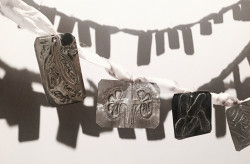Sharing stories from the world of bacteria
From her studio in Brighton, on England’s south coast, Anna Dumitriu creates BioArt works, which combine the tools of microbiology, such as bacteria, antibiotics and DNA sequences, with fine art and traditional craft techniques, such as natural dyeing and embroidery. Her creations explore the impact of infectious diseases and new technologies on society. A significant part of her recent work has revolved around antimicrobial resistance. “We are confronted by a very difficult situation now, where important antibiotic drugs we have relied on for many years have simply stopped working, because bacteria have evolved strategies to beat them. I’m fascinated how the drug discovery process works, how infectious diseases were treated in the past, and in what is happening now in scientific research to improve health”. “Make Do and Mend” was a motto in use during the World War II rationing period, which encouraged housewives to mend and darn their clothes. Anna Dumitriu adopted the motto as a title of her work related to the 75th anniversary of the first use of penicillin in a human patient in 1941. The holes of an antique wartime women’s suit were repaired with silk impregnated with E. coli bacteria. The organisms were genetically modified using a cutting edge technique called CRISPR, to remove an antibiotic resistance gene, and then “mended” with a fragment of DNA encoding the WWII slogan. This artistic genomic edit is aimed at conceptually returning the bacteria to their pre-antibiotic era state. Dumitriu collaborated with scientists from the European FET project MRG-Grammar, which is studying new means for deciphering the rules of gene regulation, and she worked at the Technion – Israel Institute of Technology in Haifa, Israel, under the FEAT (Future Emerging Art and Technology) residency programme. Dumitriu’s practice is focused on a close long-term collaboration with scientists. She has been collaborating with microbiologist John Paul, from the Brighton and Sussex University Hospitals, for over thirteen years. “I started in the lab with Dr. Paul to explore the bacterial ecosystem, which was then called bacterial normal flora but has since been rebranded as ‘the microbiome’. Over time I learned to work with infectious diseases which became my main focus for exploration. It’s a subject so close to us”. The work “MRSA Quilt” tells the story of the research on superbug Methicillin Resistant Staphylococcus aureus, resulting from an unnecessary use of antibiotics. The quilt has been patterned with the bacterium grown on chromogenic agar. This substance, which works as a medium, contains a dye causing MRSA to grow blue, and stain the cotton calico decorative squares of the quilt. The final effect shows the interactions of the organism with antibiotics. Dumitriu’s project “The Romantic Disease” explores the history of tuberculosis treatment, and new research into the whole genome sequencing of the bacterium by Modernising Medical Microbiology at the University of Oxford. Pregnant women being treated in sanatoria for TB were often forced to have abortions, in the incorrect fear that they would pass on the disease to their children in the womb. Dumitriu reworked an antique romantic era maternity dress, embroidering the front and the hem with silk dyed with safflower and madder root (plants used to treat TB in ancient times), the back shoulders with Prontosil (an early bacteriostatic drug). The garment was also trimmed with dyed flowers and bows containing bovine TB (often passed to children in cows’ milk). The dress was also impregnated with the extracted DNA of dead Mycobacterium tuberculosis. The organism was rendered sterile through a validated process used in whole genome sequencing of TB. Read more: http://www.youris.com/Society/Gallery/Sharing-Stories-From-The-World-Of-Bacteria.kl
Countries
Israel, United Kingdom

